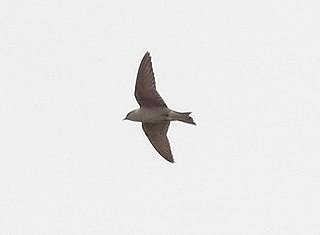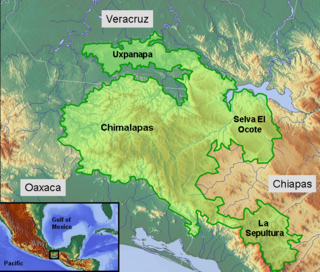
Villa's gray shrew is a shrew native to northeastern Mexico, where it is called musaraña.

Incilius tutelarius is a species of toad in the family Bufonidae. It is found in the Sierra Chimalapa and Sierra Madre de Chiapas in Guatemala and Chiapas, Mexico. Its natural habitats are cloud forests and pine-oak (broadleaf) forests. It is closely associated with streams, its breeding habitat. It is threatened by habitat loss.

Exerodonta abdivita is a species of frogs in the family Hylidae.
Exerodonta bivocata is a species of frog in the family Hylidae. It is endemic to Mexico. Its natural habitats are subtropical or tropical moist montane forests and rivers. It is threatened by habitat loss.

Exerodonta catracha is a species of frog in the family Hylidae. It is endemic to Honduras. Its natural habitats are subtropical or tropical moist montane forests, rivers, and freshwater marshes. It is threatened by habitat loss.
Exerodonta melanomma is a species of frog in the family Hylidae. It is endemic to Mexico. Its natural habitats are subtropical or tropical moist montane forests, rivers, and intermittent rivers. It is threatened by habitat loss.
Exerodonta perkinsi is a species of frog in the family Hylidae otherwise known as the Perkins' tree frog. It is endemic to Guatemala. Its natural habitats are subtropical or tropical moist montane forests, rivers, intermittent freshwater marshes, and heavily degraded former forest. It is threatened by habitat loss.

Exerodonta smaragdina is a species of frog in the family Hylidae. It is endemic to Mexico.

Exerodonta sumichrasti is a species of frog in the family Hylidae. It is endemic to Mexico and known from the Pacific slopes of southern Mexico in the Guerrero, Oaxaca, and Chiapas states as well as from the Chiapan highlands.
Exerodonta xera is a species of frog in the family Hylidae. It is endemic to Mexico. Its natural habitats are subtropical or tropical moist montane forests, subtropical or tropical dry shrubland, and rivers. It is threatened by habitat loss.

Hombron's kingfisher or the blue-capped kingfisher is a species of bird in the family Alcedinidae endemic to the Philippines and found only on Mindanao. It is one of the most colorful kingfishers in the country having a dark blue cap and wings with rufous spots, a striped rufous belly, white chin and red bill. Its natural habitats are on the upper ranges of tropical moist lowland forest and tropical moist montane forests. It is threatened by habitat loss.

The Peruvian martin is a species of bird in the family Hirundinidae. It is found in Peru and far northern Chile.

The ornate flying fox is a species of flying fox in the family Pteropodidae. It is endemic to New Caledonia. Its natural habitat is subtropical or tropical dry forests. It is threatened due to habitat destruction and hunting, the former exacerbated by high roost-site fidelity.

The lesser woolly horseshoe bat is a species of bat in the family Rhinolophidae. It is found in Brunei, Indonesia, and Malaysia. It is assessed as near-threatened by the IUCN.

Adelphicos latifasciatum, the Oaxaca burrowing snake, is a colubrid snake described by John D. Lynch and Hobart Muir Smith in 1966.

The Selva Zoque, which includes the Chimalapas rain forest, is an area of great ecological importance in Mexico. Most of the forest lies in the state of Oaxaca but parts are in Chiapas and Veracruz. It is the largest tract of tropical rainforest in Mexico, and contains the majority of terrestrial biodiversity in the country. The forest includes the Selva El Ocote, a federally-protected biosphere reserve, but is otherwise not yet protected. Despite the rich ecology of the region, a 2003 study that focused on bird populations stated that "the fauna of the heart of the Chimalapas, including its vast rainforests, have seen little or no study". As it is an impoverished region, efforts to preserve the ecology are often at odds with demands to improve the economy.
Sarcohyla miahuatlanensis, or the Sierra Miahuatlan spikethumb frog, is a species of frog in the family Hylidae. It is endemic to Mexico and only known from its type locality near Candelaria Loxicha on the Sierra de Miahuatlán in Oaxaca.
Beaucarnea sanctomariana is a tree in the family Asparagaceae, native to Mexico. The species is named for the town of Santa María Chimalapa in Oaxaca.












